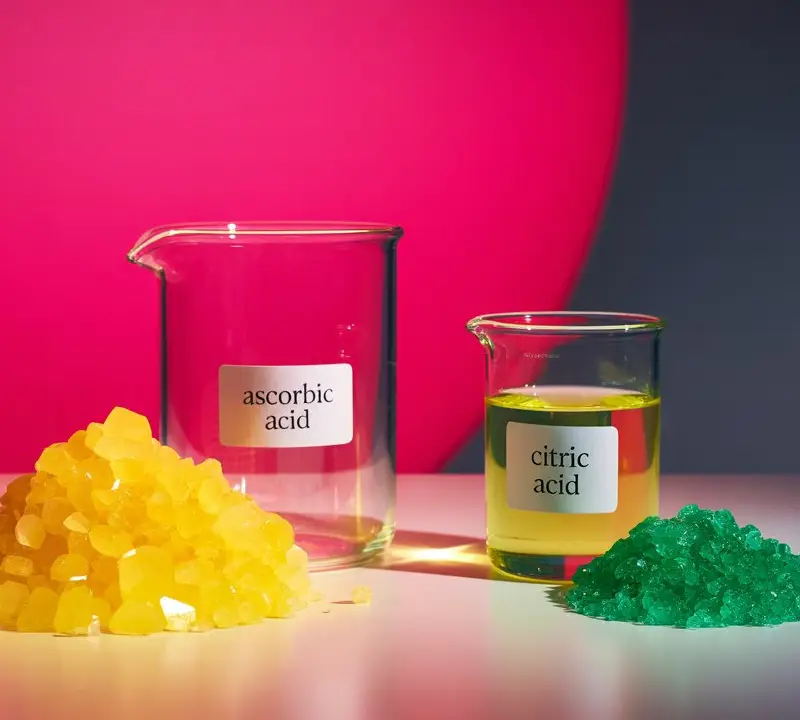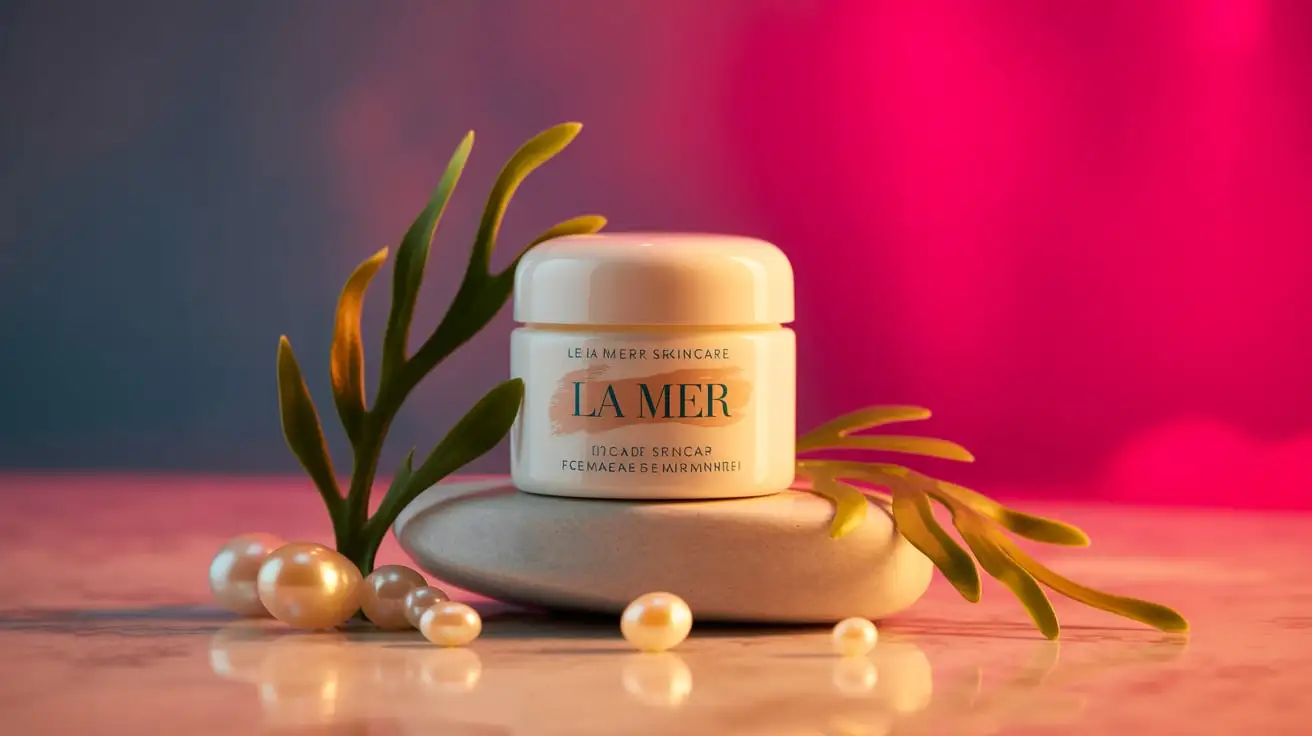
Acids are a common component in many of the products we use daily, from foods and beverages to skincare and cleaning items. They play important roles such as preserving freshness, balancing pH levels, and improving taste or texture. Two well-known acids found in everyday items are ascorbic acid and citric acid.
Table of Contents
ToggleMany people confuse these two due to their similar sources (like fruits) and shared roles in food preservation and skincare formulations. However, they are chemically different and serve distinct purposes. Ascorbic acid is a form of vitamin C, essential for health, while citric acid is mainly used as a natural preservative and flavor enhancer.
What Is Ascorbic Acid?
Chemical Structure and Origin
Ascorbic acid, scientifically known as Vitamin C, has the chemical formula C₆H₈O₆. It is a water-soluble compound and a potent antioxidant that plays a crucial role in several physiological functions. Although it’s often associated with citrus fruits, ascorbic acid can also be synthesized in laboratories for use in supplements and fortified foods.
Also Known as Vitamin C
Ascorbic acid is simply the chemical name for Vitamin C. It is essential for human health and must be obtained through diet, as the human body cannot synthesize it on its own.
Natural Sources
Vitamin C is commonly found in:
- Citrus fruits (oranges, lemons, limes)
- Berries (strawberries, blueberries, raspberries)
- Kiwifruit
- Bell peppers
- Leafy greens like spinach and kale
- Broccoli and Brussels sprouts
While citrus fruits are rich in both ascorbic acid and citric acid, it’s important to understand that they are not the same compound. Ascorbic acid provides nutritional benefits, while citric acid serves mainly as a natural preservative and flavor enhancer.
Key Benefits of Ascorbic Acid
- Immune Support: Strengthens the immune system and helps fight off infections.
- Antioxidant Power: Neutralizes free radicals, protecting cells from oxidative damage.
- Collagen Production: Vital for the synthesis of collagen, which supports skin, cartilage, and bone health.
- Iron Absorption: Enhances the body’s ability to absorb iron from plant-based sources.
What Is Citric Acid?
Chemical Structure and Origin
Citric acid is a weak organic acid with the chemical formula C₆H₈O₇. It was first isolated from lemon juice in the 18th century and is naturally present in most citrus fruits. Despite its mild acidity, it plays a significant role in various biological and industrial processes. In nature, it is a key component of the citric acid cycle (Krebs cycle), which is essential for energy production in living cells.
Naturally Found in Citrus Fruits
Citric acid is most commonly found in fruits like:
- Lemons
- Limes
- Oranges
- Grapefruits
These fruits are prized for their tangy flavor, which is largely due to their high citric acid content. This natural occurrence contributes to their widespread use in both culinary and non-culinary products.
Common Uses: Preservative and Flavoring Agent
One of the most well-known roles of citric acid is as a preservative and flavor enhancer in food and beverages. It helps maintain freshness, enhances tartness, and prevents spoilage by inhibiting microbial growth. You’ll also find citric acid in:
- Soft drinks and candies
- Canned and jarred foods
- Jams and jellies
- Skincare and cosmetic products (for pH balancing)
Although often confused with ascorbic acid due to their presence in similar foods, Citric Acid does not provide vitamin content or antioxidant benefits. Its main value lies in its ability to stabilize and enhance products.
Industrial vs. Natural Citric Acid
While citric acid naturally occurs in fruits, the majority of commercial citric acid is now produced industrially through fermentation. This involves using molds like Aspergillus niger to ferment sugars, which results in large-scale production suitable for the food, pharmaceutical, and cleaning industries.
Understanding the distinction between naturally sourced and industrial citric acid is helpful for consumers who are concerned about additives or prefer more natural ingredients in their products. Both forms are chemically identical and safe for use; however, the source may be a consideration for those seeking organic or minimally processed options.
By recognizing the unique function and origin of citric acid, consumers can make more informed choices, especially when comparing it to ascorbic acid, which offers nutritional benefits in addition to practical ones.
Key Differences Between Ascorbic Acid and Citric Acid
Although ascorbic acid and citric acid are both found in citrus fruits and are often mentioned together, they have very different properties, purposes, and effects. Here’s a breakdown of the key differences:
Chemical Composition
Ascorbic acid (Vitamin C) has the chemical formula C₆H₈O₆, while citric acid has the formula C₆H₈O₇. Despite the similarity in their molecular structures, they are distinct compounds. Ascorbic acid is a vital nutrient with antioxidant properties, whereas citric acid is a tricarboxylic acid that plays no direct nutritional role.
pH and Acidity
Both acids are acidic, but citric acid is typically more acidic in solution. It has a lower pH compared to ascorbic acid, making it more effective in adjusting acidity levels in food and cosmetic products. This stronger acidity is one reason why citric acid is so widely used in the food industry as a preservative and flavor enhancer.
Taste and Solubility
While both acids are soluble in water, their taste profiles are quite different:
- Ascorbic acid has a mildly tart, slightly bitter flavor.
- Citric acid has a sharper, tangier, and more sour taste.
This makes citric acid ideal for enhancing sourness in beverages, candies, and processed foods, while ascorbic acid is more commonly used in health supplements or to add mild tartness.
Nutritional Value
Ascorbic acid is an essential nutrient for humans—it supports immune health, collagen production, iron absorption, and serves as a powerful antioxidant. On the other hand, citric acid has no direct nutritional benefits. It does not contribute vitamins or minerals to the body but can assist with mineral absorption by modifying pH levels in the digestive system.
Functional Uses
- Ascorbic Acid: Primarily used in dietary supplements, fortified foods, and skincare products that aim to improve health or protect against oxidative stress.
- Citric Acid: Commonly used in food preservation, flavor enhancement, and as a pH adjuster in cosmetics, pharmaceuticals, and household cleaners.
Uses in Skincare
Acids are widely used in skincare for their transformative effects on the skin’s texture, tone, and overall health. Among the most popular are ascorbic acid and citric acid, both of which serve different but complementary purposes. While they’re often found in similar product types, their roles and benefits vary significantly.
Ascorbic Acid for Anti-Aging and Brightening
Ascorbic acid, or Vitamin C, is a powerhouse ingredient in modern skincare. It’s best known for:
- Brightening the skin and reducing dark spots by inhibiting melanin production.
- Stimulating collagen synthesis, which helps firm the skin and reduce fine lines and wrinkles.
- Providing antioxidant protection against environmental stressors like UV rays and pollution.
- Evening out skin tone and giving the complexion a healthy glow.
Due to its effectiveness, ascorbic acid is a go-to active in serums, creams, and brightening treatments, especially for those concerned with aging, dullness, and pigmentation.
Citric Acid as a pH Adjuster and Exfoliant
Citric Acid plays a different yet important role in skincare. As a member of the alpha hydroxy acid (AHA) family, it is commonly used to:
- Adjust the pH level of skincare formulations to ensure they are skin-compatible and effective.
- Act as a gentle exfoliant, helping to slough off dead skin cells, improve skin texture, and unclog pores.
- Enhance the absorption of other ingredients by removing the barrier of dead skin buildup.
You’ll often find citric acid in cleansers, toners, peels, and exfoliating masks where mild resurfacing is desired. It’s especially useful for people dealing with dullness, clogged pores, or uneven texture.
Which Is Better for Sensitive Skin?
When it comes to sensitive skin, the choice between ascorbic acid and citric acid depends on the individual’s tolerance and skincare goals:
- Ascorbic acid, especially in high concentrations, can sometimes cause irritation, redness, or tingling, particularly in sensitive skin types. However, more stable and buffered forms (like magnesium ascorbyl phosphate) are often better tolerated.
- Citric acid, while effective, is also an exfoliant and can irritate sensitive skin if overused or used in high concentrations. However, when used in low doses, especially as a pH adjuster, it is generally safe and gentle.
If you have sensitive skin, it’s wise to patch-test products containing either acid and start with lower concentrations. Formulas designed for sensitive skin will often use citric acid in a minimal amount, primarily to balance pH, making them more tolerable.
Uses in Food and Beverages
Both ascorbic acid and citric acid are widely used in the food and beverage industry—but for very different reasons. While they often appear on the same ingredient lists, their roles are not interchangeable. Understanding how each functions helps consumers make informed decisions about nutrition, shelf life, and flavor.
Ascorbic Acid as a Nutrient and Antioxidant
Ascorbic acid (Vitamin C) is added to food and drinks primarily for its nutritional value. It serves several important purposes:
- Vitamin Enrichment: Ascorbic acid is used to fortify juices, cereals, and snacks, helping people meet daily Vitamin C requirements.
- Antioxidant Properties: It helps prevent oxidation, which can spoil food or alter its color and flavor. For example, it slows browning in cut fruits or preserves the color of cured meats.
- Health Benefits: As a dietary supplement, it supports immune function and overall wellness, making it a common additive in functional beverages and health foods.
Citric Acid as a Preservative and Flavor Enhancer
Citric Acid plays a more practical role in food production. It is used for:
- Preservation: Citric acid lowers the pH of foods, creating an acidic environment that inhibits the growth of bacteria, mold, and yeast. This extends shelf life naturally without synthetic preservatives.
- Flavor Enhancement: It provides a sharp, tangy taste commonly associated with sodas, sour candies, fruit juices, and dressings.
- Texture and Stability: Citric acid can also act as a chelating agent, binding with minerals and stabilizing the texture and appearance of products like jams, jellies, and sauces.
Its versatility makes citric acid a staple in both home kitchens and large-scale food manufacturing.
Can They Be Used Interchangeably?
Despite their similar appearance on ingredient lists, ascorbic acid and citric acid are not interchangeable in most applications:
- Ascorbic acid provides nutritional value and works as a mild antioxidant.
- Citric acid is used for preservation and taste enhancement, not nutrition.
For example, using citric acid in place of ascorbic acid in a Vitamin C supplement would offer no nutritional benefit. Similarly, replacing citric acid with ascorbic acid in a recipe designed for preservation might not sufficiently prevent spoilage.
Uses in Supplements and Medicine
Both ascorbic acid and citric acid have important applications in the pharmaceutical and supplement industries. While they may appear together in the same products—such as effervescent tablets or multivitamins—they serve distinct purposes and offer different health benefits.
Role of Ascorbic Acid in Immune Support
Ascorbic acid, or Vitamin C, is a widely recognized supplement ingredient known for:
- Boosting the Immune System: It supports various cellular functions and enhances the body’s defense against infections.
- Promoting Wound Healing: Essential for collagen synthesis, which aids in tissue repair and regeneration.
- Antioxidant Protection: It neutralizes free radicals, reducing inflammation and cellular damage.
- Iron Absorption: Improves the absorption of non-heme (plant-based) iron, making it valuable in anemia treatments.
Because the human body cannot produce Vitamin C on its own, supplementation is especially important during times of stress, illness, or poor dietary intake.
Citric Acid in Effervescent Tablets and Mineral Absorption
Citric Acid is commonly used in medical formulations, not for its nutritional value, but for its functional properties:
- Effervescence: It reacts with bicarbonate in effervescent tablets to produce a fizzy, fast-dissolving solution that enhances taste and makes supplements easier to consume.
- Mineral Chelation: Citric acid can bind with minerals like calcium, magnesium, or zinc, improving their solubility and absorption in the digestive tract.
- pH Regulation: Helps stabilize liquid formulations and adjust acidity in medications to improve shelf life and palatability.
You’ll often find citric acid in supplements like calcium citrate, where it plays a role in making minerals more bioavailable.
Safety and Recommended Dosage
- Ascorbic Acid: The recommended daily intake for adults is around 65–90 mg, with an upper limit of 2,000 mg per day. Excess intake may cause mild side effects like stomach upset or diarrhea.
- Citric Acid: Generally recognized as safe (GRAS) by food and drug authorities when used appropriately. While it’s not taken for health benefits, it is well-tolerated in supplements and medications. Overuse in large amounts may cause tooth enamel erosion or digestive irritation in sensitive individuals.
Always follow label instructions or consult a healthcare provider when using supplements, especially if combining ascorbic acid and citric acid in high doses or specialized formulas.
Side Effects and Safety
While ascorbic acid and citric acid are generally safe for most people when used appropriately, it’s important to be aware of potential side effects, allergies, and usage limits—especially for those with sensitive skin, dietary restrictions, or underlying health conditions.
Possible Irritations or Allergies
- Ascorbic Acid: In skincare, high concentrations of Vitamin C (ascorbic acid) can sometimes cause redness, tingling, dryness, or mild irritation—especially in sensitive or acne-prone skin. When ingested in excessive amounts, it may lead to gastrointestinal upset, including diarrhea or nausea.
- Citric Acid: Though widely used, Citric Acid can also cause reactions in some individuals. Topically, it may cause stinging or irritation, particularly when used in high concentrations or on broken skin. In rare cases, people may experience allergic contact dermatitis. When consumed in large amounts (e.g., in acidic drinks), it may contribute to enamel erosion and stomach discomfort.
FDA and General Safety Guidelines
- Both ascorbic acid and citric acid are classified as “Generally Recognized as Safe” (GRAS) by the U.S. Food and Drug Administration (FDA) when used in regulated amounts.
- In supplements and foods, they are subject to dosage limits and manufacturing standards to ensure consumer safety.
- In cosmetics, both ingredients are allowed in over-the-counter (OTC) formulations, provided they adhere to safe concentration guidelines.
These regulations help ensure that the acids are safe for daily use in food, medicine, and skincare when used as intended.
When to Consult a Professional
You should consider consulting a healthcare provider or dermatologist if:
- You experience persistent skin irritation or allergic reactions after using products containing ascorbic acid or citric acid.
- You are pregnant, breastfeeding, or managing a chronic condition that may affect how your body processes supplements.
- You plan to take high-dose Vitamin C supplements regularly.
- You have a history of kidney stones, as excess Vitamin C can increase oxalate levels in the body.
Which One Should You Use?
Choosing between ascorbic acid and citric acid depends entirely on your goals—whether you’re focusing on skincare, nutrition, or food preservation. While they’re sometimes found in the same product, each has its own unique function, and understanding these roles can help you pick the right ingredient for your needs.
For Skincare
- Use Ascorbic Acid if you’re looking to brighten your skin, reduce hyperpigmentation, stimulate collagen, or protect against environmental damage. It’s ideal for anti-aging and glow-boosting routines.
- Use Citric Acid if you’re aiming to gently exfoliate, smooth skin texture, or maintain the right pH in skincare formulations. It’s often found in toners, masks, and chemical peels.
Tip: If you have sensitive skin, start with low concentrations of either acid, and patch-test to minimize irritation.
For Food and Beverages
- Use Ascorbic Acid when you want to add nutritional value—especially Vitamin C—to juices, snacks, or preserved fruits. It also helps prevent browning and oxidation.
- Use Citric Acid when your goal is to enhance flavor, add sourness, or extend shelf life by preventing microbial growth. It’s a common additive in sodas, candies, sauces, and even homemade preserves.
Tip: If you’re preparing something for long-term storage, Citric Acid is the better choice for its preservative power.
For Health and Supplements
- Use Ascorbic Acid to support your immune system, improve iron absorption, and boost antioxidant protection. It’s especially helpful during illness, stress, or when your diet lacks fresh produce.
- Use Citric Acid in supplement form (like calcium citrate) if you’re aiming to improve mineral absorption or prefer effervescent tablets that dissolve easily in water.
Tip: Always follow dosage instructions, and consult a professional if you’re using either acid regularly in high amounts.
Conclusion
In summary, while ascorbic acid and citric acid are both naturally found in citrus fruits and commonly used in various products, they serve very different functions. Ascorbic acid is a vital nutrient—better known as Vitamin C—offering significant health benefits such as immune support, antioxidant protection, and collagen production. In contrast, citric acid is primarily valued for its role as a preservative, flavor enhancer, and pH adjuster in foods, skincare, and supplements. Consumers should choose ascorbic acid when their goal is nutritional support or antioxidant care, while citric acid is more suitable for preserving freshness, enhancing taste, or maintaining product stability. Being aware of these distinctions allows you to make more informed and effective choices, whether you’re selecting a supplement, a face serum, or a packaged food item.
FAQs
Is ascorbic acid the same as citric acid?
No, ascorbic acid (Vitamin C) and citric acid are different compounds. Ascorbic acid is a vitamin with antioxidant properties, while citric acid is a weak organic acid commonly used as a preservative and flavor enhancer.
Can citric acid be used as a substitute for ascorbic acid?
Not exactly. While both are found in citrus fruits and have acidic properties, citric acid does not provide the same nutritional benefits as ascorbic acid (Vitamin C). They are not interchangeable in supplements or for health purposes.
Which is better for skin: ascorbic acid or citric acid?
Ascorbic acid is generally better for skincare due to its antioxidant and brightening effects. Citric acid is used more for exfoliation and pH balancing, but it can be irritating for sensitive skin.
Are ascorbic acid and citric acid safe to consume?
Yes, both are considered safe for consumption in moderate amounts. Ascorbic acid is an essential nutrient (Vitamin C), and citric acid is widely used as a food additive. However, excessive intake may cause stomach upset.
Do both ascorbic acid and citric acid occur naturally in fruits?
Yes, both acids are naturally found in citrus fruits like oranges and lemons. However, their roles differ—ascorbic acid provides Vitamin C, while citric acid gives the fruit its tart flavor.


